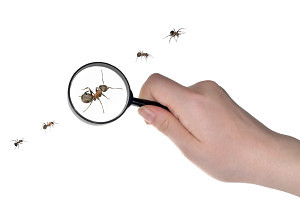Three quarantine projects to bolster your household pest protection.
As the nation hunkers down to mitigate the COVID-19 threat, many of us are suffering from a less concerning but troublesome condition: cabin fever.
While we all do our part to protect our communities, why not take a chance to improve your life. I’m not going to recommend a new exercise routine, hobby, or instrument. Instead,
1- Perform some basic exclusion around the exterior of your home.
Exclusion is the process of sealing your home against pests. Cracks or gaps in the exterior can be exploited by pest invaders as a way into your home.
Start by walking around the outside of your home. Here are a few things to be on the lookout for:
-Cracks in the foundation
-Wood to ground contact
-Holes or gaps in siding
-Windows and doors with missing or damaged weather stripping
-Unscreened vents
-Trash receptacles or pet food storage that is not properly sealed
Some pests can get into gaps of less than a quarter of an inch, so you’ll want to be very thorough with your search.
2- Clean out food storage, cabinets, and food prep areas.
Kitchens and pantries are one of the main draws for pests invading your home. A bountiful supply of food and moisture can provide scavengers and even entire colonies plenty of resources to grow and thrive.
Naturally, no one wants pests thriving off your groceries, so here’s what you should do:
Start by clearing out cabinets and other storage areas, throw away anything that’s gotten out of date or have damaged packaging. Once that is done, carefully inspect your now cleared storage for any signs of pest activity.
Pests don’t go through your food quickly, and sometimes a single bag of dried food can attract pests for years. The last thing you want is an infestation inside your pantry.
Next, take a look at the kitchen itself. Stains, crumbs, and food scraps may seem insignificant to you, but to a pest, they are a desirable prize. Cleaning all of those “out of the way and hard to reach” areas of your kitchen will mitigate this risk.
Note that pet food is not an exception to this rule. Pet food stored outdoors or in a garage can draw insect and wildlife pests from far and wide.
3-Give your attic and basements the spring cleaning treatment.
Let’s start with the attic. Wildlife pests such as squirrels, mice, or birds are common attic dwellers. Often, pests sneak in through a damaged section of the roof, but some pests such as squirrels can also gnaw their own path into the home if given the opportunity.
A wildlife infestation in your attic can be a major risk.
For one, many rodent pests gnaw through insulation, pipes, and wiring while gathering materials for their nests. This can require expensive repairs and may even create a fire risk.
When inspecting your attic for pests, let your nose be the guide. While it’s rather gross to contemplate, often the most obvious sign of pest activity is the presence (and smell!) of feces.
Basements can also attract a wide variety of pests. Insect pests such as cockroaches prefer to live in lowlight areas, so the basement is ideal for them. They also tend to congregate in areas with high moisture, so check around your hot water heater and other appliances.
Living pest-free during and after COVID-19:
It’s tough to determine just how long this quarantine will last, but there’s no reason not to make improvements if you have some spare time. This is in no way an ideal situation, but we must make the best of it!
For more pest control tips and advice, call Canton Termite and Pest Control. As an essential service, we remain fully operational and are in the field tackling pest threats around the Cherokee County area.
The coronavirus may have slowed life down, but pests show no signs of stopping. Take this chance to fortify your home against the spring swarming season.
To learn how you can live pest free, give us a call TODAY at 770-479-1598!
By: Tim

